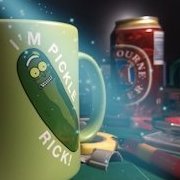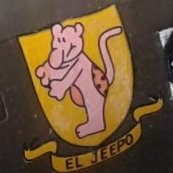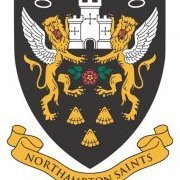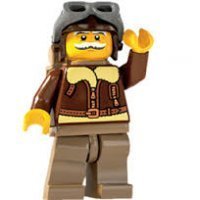-
Posts
470 -
Joined
-
Last visited
-
Days Won
2
Michael louey's Achievements

Established Member (3/9)
1.2k
Reputation
-
Hi Roger, Sorry - late to the party. Just saw you're building a DAF Typhoon. I did this a number of years ago - Note the planes had a tropical filter - can't recall if the Brengun kit supplied the part (I don't think they did as I used a Red Roo part). The later tropical filter for ETO aircraft isn't the same. Remember the DAF Typhoons had a 3 blade prop (the Brengun kit has this). I think the Airfix is a 4 blader. Can't recall any other differences. I got advice that the DAF examples may not have the tail strengthening plates I added. Just did some research - looks like the Airfix kit has the later "Tempest tail" - i.e larger tailplanes. Not sure if it needs changing at this late stage. https://www.hyperscale.com/2013/reviews/kits/airfixa02041reviewmd_1.htm Compare the Brengun parts with the Airfix ones. Hope this helps Michael
-
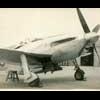
Valom 1/72 Heinkel 119V3
Michael louey replied to Michael louey's topic in Ready for Inspection - Aircraft
Thanks for all the comments. It really is a strange beast isn't it. Obviously it turned out to be a dead end though Heinkel did revive the concept of coupled engines in their 177 which didn't turn out that well. Cheers Michael -

IBG 1/72 Focke Wulf 190D-15 Prototype
Michael louey replied to Michael louey's topic in Ready for Inspection - Aircraft
Thanks for all the feedback. Roman is correct, the kit is a bit over engineered. It reminds me of an Eduard kit with a few more limitations due to the manufacturer being smaller than Eduard. Luckily the only real etch which is much worry are the bracing inside the undercarriage bay - if done expertly it will look better than the solid representation in most kits but getting the pieces bent well needs a lot of skill and appears you need to get it right first time. The big plus for the IBG kits is they are the 1st kit (other than maybe some limited run AZ kits) in this scale with the correct open undercarriage bays. I'll see if its any easier with the D-9. The Eduard Spitfires got a bit easier with subsequent builds. Its been ages since I built an Eduard 190A but I recall that was a difficult kit too and hope I remember pitfalls for the next one. Cheers Michael -

1:72 Hasegawa F-18F RAAF
Michael louey replied to dragan_mig31's topic in Ready for Inspection - Aircraft
Looks great - the weathering is spot on. Really looks like its just left the flightline at Amberley. -
The IBG 190 was my 2nd last completed build. It was nice though not a perfect kit. The main issues I had with it were the etch metal parts and the spinner. Having read Mark's (Hobbykiller) (on the 72nd scale Aircraft site) detailed build diary helped a lot. I found the etch much too soft which was good for the wheel well interior but not for items such as the undercarriage bracing or aerials. The metal would kink easily and was hard/impossible to flatten out again. The lack of a spinner backplate seems an odd omission and I didn't do a great job with my scratchbuild of one. This resulted in messing up the whole prop/spinner assembly after completion - I fixed it as best I could but its something that really needs a better approach for the next kit. The bottom wing aerial really won't work - folding the soft etch and then making it look like a single solid piece is a fools errand - I've used replacement etch/resin for small parts like this aerial, df loop and pitot tube. All the rest is from the kit. The camouflage is pretty much the kit instructions - I do have the Japo book showing the prototype in pieces after the war and not sure about some of the nose camouflage pattern but lacking anything better I've just replicated IBG's scheme. I misted on one of the RLM greens which was used to tone down the light fuselage sides and then added the mottles trying to match the photos in the Japo book I've started on a D-9 but it's on the backburner while I work on an Arado 196 and the new Airfix Me 410 which jumped the queue. The D-15 was the only IBG kit here in Australia for a long time hence why it was first in the production line. The supply chain finally sorted itself out and pretty much the full range of kits is here. Cheers Michael
- 7 replies
-
- 23
-

-

-
The club is doing a Floatplane display for the coming Model Expo so one of the guys threw open his collection to add move variety to the display (He has very esoteric tastes). The kits were free on the proviso they were completed for the display. I chose the He 119 as it really is a weird looking aeroplane. I think it was really only designed for record breaking/propaganda purposes though I should read up more about it. The whole concept of coupled engines driving a propeller shaft between the pilot and navigator in a full glasshouse cockpit sounds zany. The V3 floatplane seems even more zany. I also don't envy the poor guy (radio operator/engineer?) in the rear of the plane completely cut off from the rest of the crew. For a short run kit I didn't find the kit too bad. What is bad are the instructions and decal accuracy. There are at least 3 or 4 major issues with the instructions including fantasy guides for the float struts, the radio operator compartment being shown the wrong way around for installation and the lack of notes about using the wheel well covers to fill the holes in the underwing and tail. Also, take care when masking the canopy. It appears the glazing is asymmetrical with less framing on the pilot side. The moulded frames on the transparencies appear to be ok but the side views show extra bracing as per the navigator side. Photos of the real plane aren't clear enough but it makes sense to have better visibility for the pilot even if it means more cost/complications in production. The decal quality is good though care needs to be used as they are ultra thin and fold easily. The main problem with them is the font size of the wing serial which appear 50% bigger than the instructions indicate and would hardly fit the wing in any logical alignment. The "Heinkel" wording is also oversize though luckily for me, it is not present (though the painting guide indicates otherwise) for the scheme I chose. I replaced the wing letters with some Techmod ones I had which seem a bit small compared to the instructions but they were the largest ones I had in the right font. There are no clear pictures of the upper/lower wings showing the registration so the size of them is probably up for debate in any case. The only really problems I had with the kit were fitting the struts for the floats - I made a real hash of this and discovered it was due to using some superglue which had gone off and worked but not very well. This required resanding/respraying of the floats and struts. I personally think the crew should have been given an Iron Cross just for volunteering to fly this thing. The sounds/heat and vibration in the cockpit must have been horrendous. Cheers Michael
- 10 replies
-
- 42
-

-
Hi Lysander, Tempestfan is correct - Chris Shores books would be very authoritative but they aren't picture books, though there are some photos in them. There is this book but it is basically only on the one aircraft. https://www.amazon.com.au/Focke-Wulf-Fw-190-North-Africa/dp/1903223458 A really old picture book in the "At War" series has quite a few photos but it is basically only on the Commonwealth airforces. https://www.wearenotashop.com/product/desert-air-force-at-war-by-chaz-bowyer-and-christopher-shores/ There are a number of RAAF squadron histories covering the North African campaign but they're very specialised and have limited photos. Good Luck Michael
-

79 Squadron RAAF - White Leading Edges - Spitfire VIII
Michael louey replied to Olmec Head's topic in Aircraft WWII
Hi, The Eduard Aussie 8 Instructions were based on Peter M's guidance. Aircraft leading edges were very individual so if possible, it's best to base it on a picture of the actual airframe. The colour schemes are in the instructions which are available here: https://www.scalemates.com/products/img/8/4/0/1022840-32-instructions.pdf The kit also includes a book with photos of the actual aircraft. This includes the plane you're planning to build. Regards Michael -

1:72 SH CAC Wirraway
Michael louey replied to dragan_mig31's topic in Ready for Inspection - Aircraft
Nicely done, mine has been on the build bench for over a year 😪 -

1:48 Brewster B339 Buffalo, 25 Sqn RAAF
Michael louey replied to Dunny's topic in Ready for Inspection - Aircraft
Hi Roger, Very nice build! Just a note for anyone wanting 100% accuracy for RAAF home based Buffalos - The Australian based (rather than Singapore based) aircraft were similar to F2-A3's and had a longer fuselage. The extra length was between the windscreen and the firewall (ahead of the wing leading edge). Special Hobby has a kit which covers this version. https://www.scalemates.com/kits/special-hobby-sh48057-buffalo-model-339-23-in-raaf-and-usaaf-colors--112191 The kit isn't as easy to build or as sharp as the Tamiya though. You're correct about the 1st picture showing John Bailey. He wrote an autobiography with some pictures including this one. https://www.elizabethsbookshop.com.au/shop/latest-arrivals/buffalos-boomerangs-and-kittyhawks-memoirs-of-an-raaf-wwii-pilot/ Regards Michael -
Just for information, high back XVI aren't all that rare. A while back I thought I might be able to build a low back Spitfire in RAAF scheme however all the Mk XVI's listed on ADF serials appear to be high back versions. Here's the relevant page with serials: http://www.adf-serials.com.au/spitfire.htm
-

Me-109B 1/72 Dora Wings
Michael louey replied to Dmitry Stelmakh's topic in Ready for Inspection - Aircraft
Very nice build! I have one of these - from memory, the company has moulded the join on the underwing in a very unnatural way - you've done a great job in hiding this. Cheers Michael -
I agree with MDriskill The "easiest and nicest looking kit" is the Tamiya but the cockpit dimensions don't match the other FW190 kits. The AZ kits are a bit fiddly to build but looks ok once finished - I've only built the A-1 and had to do some work arounds and part replacements (e.g. Hasegawa clear parts) to get it finished to a nice enough standard. The Zvezda kits is good but it only represents a specific version of the A-4 and will be a bit of work to convert to an A3 or earlier version (i.e. no cooling slots). It also has a incorrectly shaped spinner which I replaced with a Barracuda item. Also watch out for sink marks in this kit and also note the canopy is made from some alternative material - won't polish up very well. I think I replaced these with more spare Hasegawa clear parts. Cheers Michael
-
Hi, 72ndSqdn has already supplied all the details - I came to the same conclusions after reading the book - I built this plane a couple of years back on this site: https://www.britmodeller.com/forums/index.php?/topic/235102623-172-eduard-spitfire-viii-a58-429-rima-iii-452-squadron-raaf/ Cheers Michael
-

Kora CAC CA-15 - My First Resin Kit
Michael louey replied to Beggsy's topic in Work in Progress - Aircraft
You're right about the postage costs from Aviation Megastore - I managed to amorphize some of the postage by buying some other items which were hard to source. The Kora kit has the advantage of a one piece wing compared to the CMR which has 2 separate wings which need to be set to symmetrical dihedral and pinned for some strength. I've seen this kit built with uneven dihedral though the overall finish of the kit was very good - so it isn't a trivial job. Cheers Michael- 11 replies


